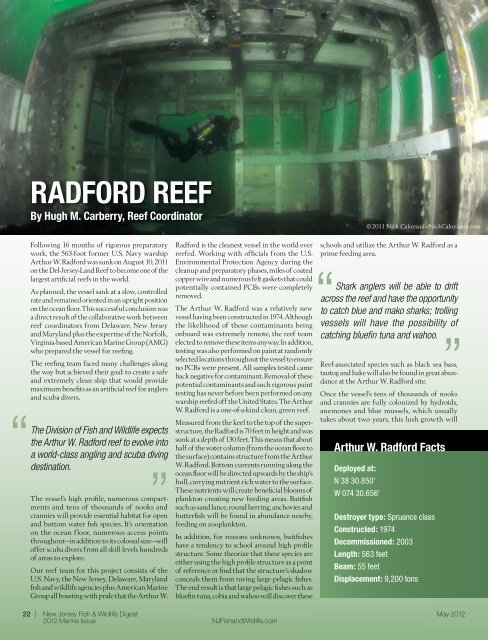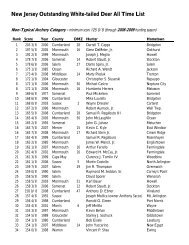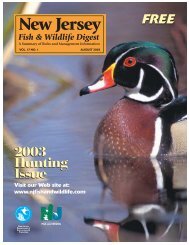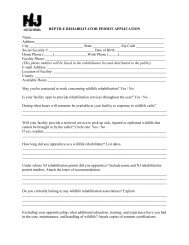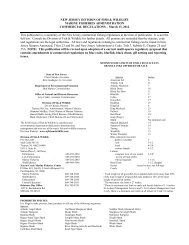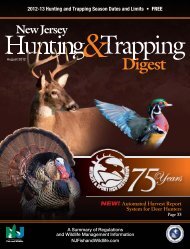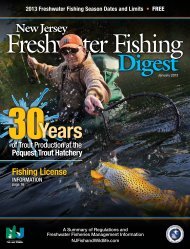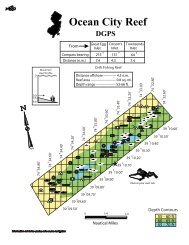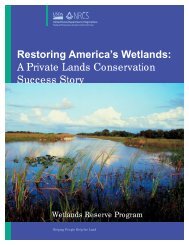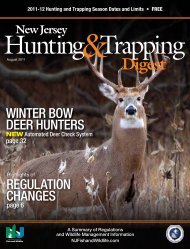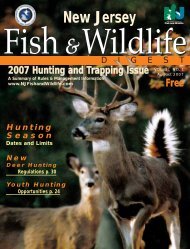Radford reef - Division of Fish and Wildlife
Radford reef - Division of Fish and Wildlife
Radford reef - Division of Fish and Wildlife
Create successful ePaper yourself
Turn your PDF publications into a flip-book with our unique Google optimized e-Paper software.
<strong>Radford</strong> ReefBy Hugh M. Carberry, Reef Coordinator©2011 Nick Caloyianis/NickCaloyianis.comFollowing 16 months <strong>of</strong> rigorous preparatorywork, the 563-foot former U.S. Navy warshipArthur W. <strong>Radford</strong> was sunk on August 10, 2011on the Del-Jersey-L<strong>and</strong> Reef to become one <strong>of</strong> thelargest artificial <strong>reef</strong>s in the world.As planned, the vessel sank at a slow, controlledrate <strong>and</strong> remained oriented in an upright positionon the ocean floor. This successful conclusion wasa direct result <strong>of</strong> the collaborative work between<strong>reef</strong> coordinators from Delaware, New Jersey<strong>and</strong> Maryl<strong>and</strong> plus the expertise <strong>of</strong> the Norfolk,Virginia-based American Marine Group (AMG)who prepared the vessel for <strong>reef</strong>ing.The <strong>reef</strong>ing team faced many challenges alongthe way but achieved their goal: to create a safe<strong>and</strong> extremely clean ship that would providemaximum benefits as an artificial <strong>reef</strong> for anglers<strong>and</strong> scuba divers.“The <strong>Division</strong> <strong>of</strong> <strong>Fish</strong> <strong>and</strong> <strong>Wildlife</strong> expectsthe Arthur W. <strong>Radford</strong> <strong>reef</strong> to evolve„intoa world-class angling <strong>and</strong> scuba divingdestination.The vessel’s high pr<strong>of</strong>ile, numerous compartments<strong>and</strong> tens <strong>of</strong> thous<strong>and</strong>s <strong>of</strong> nooks <strong>and</strong>crannies will provide essential habitat for open<strong>and</strong> bottom water fish species. It’s orientationon the ocean floor, numerous access pointsthroughout—in addition to its colossal size—will<strong>of</strong>fer scuba divers from all skill levels hundreds<strong>of</strong> areas to explore.Our <strong>reef</strong> team for this project consists <strong>of</strong> theU.S. Navy, the New Jersey, Delaware, Maryl<strong>and</strong>fish <strong>and</strong> wildlife agencies plus American MarineGroup all boasting with pride that the Arthur W.<strong>Radford</strong> is the cleanest vessel in the world ever<strong>reef</strong>ed. Working with <strong>of</strong>ficials from the U.S.Environmental Protection Agency during thecleanup <strong>and</strong> preparatory phases, miles <strong>of</strong> coatedcopper wire <strong>and</strong> numerous felt gaskets that couldpotentially contained PCBs were completelyremoved.The Arthur W. <strong>Radford</strong> was a relatively newvessel having been constructed in 1974. Althoughthe likelihood <strong>of</strong> those contaminants beingonboard was extremely remote, the <strong>reef</strong> teamelected to remove these items anyway. In addition,testing was also performed on paint at r<strong>and</strong>omlyselected locations throughout the vessel to ensureno PCBs were present. All samples tested cameback negative for contaminant. Removal <strong>of</strong> thesepotential contaminants <strong>and</strong> such rigorous painttesting has never before been performed on anywarship <strong>reef</strong>ed <strong>of</strong>f the United States. The ArthurW. <strong>Radford</strong> is a one-<strong>of</strong>-a-kind clean, green <strong>reef</strong>.Measured from the keel to the top <strong>of</strong> the superstructure,the <strong>Radford</strong> is 70 feet in height <strong>and</strong> wassunk at a depth <strong>of</strong> 130 feet. This means that abouthalf <strong>of</strong> the water column (from the ocean floor tothe surface) contains structure from the ArthurW. <strong>Radford</strong>. Bottom currents running along theocean floor will be directed upwards by the ship’shull, carrying nutrient rich water to the surface.These nutrients will create beneficial blooms <strong>of</strong>plankton creating new feeding areas. Baitfishsuch as s<strong>and</strong> lance, round herring, anchovies <strong>and</strong>butterfish will be found in abundance nearby,feeding on zooplankton.In addition, for reasons unknown, baitfisheshave a tendency to school around high pr<strong>of</strong>ilestructure. Some theorize that these species areeither using the high pr<strong>of</strong>ile structure as a point<strong>of</strong> reference or find that the structure’s shadowconceals them from roving large pelagic fishes.The end result is that large pelagic fishes such asbluefin tuna, cobia <strong>and</strong> wahoo will discover theseschools <strong>and</strong> utilize the Arthur W. <strong>Radford</strong> as aprime feeding area.“Shark anglers will be able to driftacross the <strong>reef</strong> <strong>and</strong> have the opportunityto catch blue <strong>and</strong> mako sharks; trolling„vessels will have the possibility <strong>of</strong>catching bluefin tuna <strong>and</strong> wahoo.Reef-associated species such as black sea bass,tautog <strong>and</strong> hake will also be found in great abundanceat the Arthur W. <strong>Radford</strong> site.Once the vessel’s tens <strong>of</strong> thous<strong>and</strong>s <strong>of</strong> nooks<strong>and</strong> crannies are fully colonized by hydroids,anemones <strong>and</strong> blue mussels, which usuallytakes about two years, this lush growth willArthur W. <strong>Radford</strong> FactsDeployed at:N 38 30.850'W 074 30.656'Destroyer type: Spruance classConstructed: 1974Decommissioned: 2003Length: 563 feetBeam: 55 feetDisplacement: 9,200 tons22 | New Jersey <strong>Fish</strong> & <strong>Wildlife</strong> Digest May 20122012 Marine Issue NJ<strong>Fish</strong><strong>and</strong><strong>Wildlife</strong>.com
attract <strong>and</strong> provide refuge for shrimp, lobsters<strong>and</strong> stone crabs, providing an eclectic menu forfish. Early reports from scuba divers who dovethe <strong>Radford</strong> <strong>reef</strong> between August <strong>and</strong> October2011 documented droves <strong>of</strong> black seabass <strong>and</strong>even a wahoo. This vessel will last more than100 years on the ocean floor <strong>of</strong>fering recreationalopportunities for generations to come.Scuba divers from New Jersey who have traveledto Florida to dive the 904-foot aircraftcarrier Oriskany or the 522-foot missile rangeinstrumentation ship V<strong>and</strong>enberg now have a563-foot warship in their own backyard. TheDel-Jersey-L<strong>and</strong> Reef is located only 28.5 nauticalmiles south <strong>of</strong> Cape May Point. The vessel’s highvertical pr<strong>of</strong>ile makes it the perfect scuba divefor beginner, novice <strong>and</strong> expert wreck divers.Beginners can descend to the upper level <strong>of</strong> theship (60–65 feet below the surface) <strong>and</strong> explorethe <strong>Radford</strong>’s wheel house <strong>and</strong> structures thatheld antisubmarine weapons. Novice divers canswim along the upper deck <strong>and</strong> peer down intothe silos that held tomahawk cruise missiles orpenetrate into the chain locker room that heldhundreds <strong>of</strong> shots <strong>of</strong> chain for the vessel’s massiveanchors. (Each shot <strong>of</strong> anchor chain is 15 fathoms,or 90-feet long.) Experienced wreck divers <strong>and</strong>technical divers can penetrate into the deepersections <strong>of</strong> the ship <strong>and</strong> explore the engine roomsor descend down an elevator shaft to the deepestportions <strong>of</strong> the ship.Wreck divers will be pleased to find that theArthur W. <strong>Radford</strong> is an extremely “diverfriendly” <strong>reef</strong>. All steel doors <strong>and</strong> hatches thatcould potentially close behind scuba divers havebeen removed, overhanging wires that couldensnare dive gear were taken down <strong>and</strong> numerousaccess panels were cut on the sides <strong>of</strong> the hull forpenetrating inside. In addition to the side holes,the upper deck was also cut at strategic locationsto increase the ambient light entering the vessel.The increased visibility within the ships interiorresulting from hull <strong>and</strong> deck modifications alongwith the cavernous areas inside all provide atarget-rich environment for spear gun hunters. Inparticular, from the helipad deck near the sternto the end <strong>of</strong> the superstructure near the bowlies a 300-foot alleyway that is wide <strong>and</strong> highenough to allow three tractor trailers to drivethrough side-by-side.“ „This area will become a spear gunhunters dream for shooting trigger fish,tautog <strong>and</strong> black sea bass.The tri-state <strong>reef</strong> team <strong>and</strong> American MarineGroup did everything possible to make the <strong>reef</strong>diver-friendly <strong>and</strong> to sink the <strong>Radford</strong> upright<strong>and</strong> intact, but Mother Nature had somethingelse in store. Just 17 days following the ship’sdeployment, Hurricane Irene madea direct hit over the Del-Jersey-L<strong>and</strong>Reef. Scuba divers from Ocean City,Maryl<strong>and</strong> who dove shortly thereafterdocumented that the <strong>Radford</strong> hadbroken into three pieces. This newscame as a shock to all <strong>of</strong> the <strong>reef</strong>partners. Evidently, the energyreleased from Hurricane Irene wasno match for even a former U.S. Navydestroyer. While this unexpectedchange is unfortunate, ultimatelythe <strong>reef</strong>’s productivity will increase.Scuba divers will now have easier <strong>and</strong> completeaccess to all compartments <strong>and</strong> additionalambient light will enter the vessel. <strong>Fish</strong>ingcharters <strong>and</strong> dive boats can dive <strong>and</strong> fish oneach portion separately, eliminating the needto jockey for position while anchoring. The hullbreakage also created a measurable increase inthe surface area which will increase the <strong>reef</strong>’sfish drawing power. The hull separation willalso allow lobsters to enter the interior <strong>of</strong> thevessel instead <strong>of</strong> just burrowing beneath thehull at the ocean floor.Del-Jersey-L<strong>and</strong> Inshore DGPSFROMCompassBearingDistance(n.m.)Distance Offshore.............28.5 n.m.Reef Area.......................1.46 sq. mi.Depth Range..................121–131 ft.0'60'121'131'TownsendsInletMaximumReef Pr<strong>of</strong>ileDepth Contours120–125 ft.125–130 ft.130–135 ft.HerefordInlet©2011 Nick Caloyianis/NickCaloyianis.comCape MayInlet179° 169° 158°41.7 35.62 33.7The <strong>Division</strong> <strong>of</strong> <strong>Fish</strong> <strong>and</strong> <strong>Wildlife</strong>wants to hear about your excursionsto the Arthur W. <strong>Radford</strong>.Contact us at (609) 748-2022 to share yourfishing reports <strong>and</strong> diving observations. We valueyour feedback, whether complimentary or critical.Your suggestions, comments <strong>and</strong> observationsultimately make us better <strong>reef</strong> managers.Go <strong>and</strong> enjoy the Arthur W. <strong>Radford</strong>!May 2012 New Jersey <strong>Fish</strong> & <strong>Wildlife</strong> Digest | 23NJ<strong>Fish</strong><strong>and</strong><strong>Wildlife</strong>.com2012 Marine Issue
Skillful AnglerAwards ProgramThe Skillful Angler Awards Program is designedto supplement the New Jersey Record <strong>Fish</strong>Program. It is comprised <strong>of</strong> three categories:Adult (for anglers age 16 <strong>and</strong> older), Junior (underage 16) <strong>and</strong> Catch <strong>and</strong> Release (based on length).A clear, side-view photo that allows accuratespecies identification must be included with eachapplication. All photo entries become property <strong>of</strong><strong>Fish</strong>ing the Barnegat Light the <strong>Division</strong> <strong>of</strong> <strong>Fish</strong> <strong>and</strong> <strong>Wildlife</strong> <strong>and</strong> will not beReef, John Howell caught this returned. Well-composed, high resolution photos4.24-pound black sea bass.may be selected for printing in future Digests.The Skillful Angler Awards program acknowledges that many anglers catchfreshwater <strong>and</strong> marine fish that are not record size, but are still worthy <strong>of</strong> recognitionbecause the size <strong>and</strong> weight <strong>of</strong> the fish sufficiently tested the angler’sskill. The program is open to resident <strong>and</strong> non-resident anglers. All fish must becaught in New Jersey waters using a hook <strong>and</strong> line during legally open seasons.Anglers qualifying for a Skillful Angler award receive a certificate <strong>and</strong> abronze pin to adorn their fishing hat or jacket. Only one pin <strong>and</strong> certificateper species—regardless <strong>of</strong> category—will be awarded annually to eachparticipant, but an angler may submit applications for larger fish caughteven after receiving a pin.At the end <strong>of</strong> the year, special recognition is given to anglers who catchthe largest fish in each species category. The winner <strong>of</strong> each category is senta special certificate recognizing his or her accomplishment as the best <strong>of</strong>New Jersey’s Skillful Anglers.<strong>Fish</strong> must be measured from the tip <strong>of</strong> the nose (with mouth closed) tothe tip <strong>of</strong> the tail (see Measuring <strong>Fish</strong> page 12). For Catch <strong>and</strong> Releasecategories, fish must be photographed alongside a ruler. For Adult/Juniorcategories, fish must be weighed <strong>and</strong> measured by fishing license agents,tackle shops or authorized <strong>Fish</strong> <strong>and</strong> <strong>Wildlife</strong> fisheries biologists.Learn more online at NJ<strong>Fish</strong><strong>and</strong><strong>Wildlife</strong>.com/skflang.htm.New Jersey Skillful Angler ApplicationName________________________________________ Age________Address____________________________________________________________________________________________________City_______________________________State________ Zip_________Daytime Telephone Number (________)___________________________Entry Category (check only one):❑ Adult ❑ Junior (16 years <strong>and</strong> under)❑ Catch <strong>and</strong> Release (qualification based on length)<strong>Fish</strong> Species (Angler must complete. Subject to verification by a state biologist.)________________________________________________________Weight_______lb(s).,_______oz. Length_______in. Girth_______in.Date Caught*_______/_____/________ Time_____________Location_______________________________________________Caught from (check only one):❑ Boat ❑ Shore ❑ Surf ❑ Jetty❑ Other (specify)___________________________________________Minimum Entry Requirements:SpeciesAdult Weight(lbs., oz.)Junior Weight(lbs., oz.)Catch &Release(inches)Black Sea Bass 4 3 20Striped Bass 40 36 42Black Drum 70 63 46Bluefish 18 16 33Cod 30 27 42Dolphin 30 27 n/aWinter Flounder 2 1 lb., 8 oz. 16Fluke 8 7 27Kingfish 1 8 oz. 13Mako Shark 250 225 n/aBlue Marlin 400 360 n/aWhite Marlin 60 54 n/aPollock 25 22 lbs., 8 oz. 41Tautog 8 7 22Albacore Tuna 50 45 n/aBig Eye Tuna 200 180 n/aBluefin Tuna 500 450 n/aYellowfin Tuna 120 108 n/aTuna (other) 250 225 n/aWeakfish 10 9 30The New Jersey State Record <strong>Fish</strong> Program requires a separate application<strong>and</strong> is based on weight alone. Scale certification documentation <strong>and</strong> aweighmaster’s signature are necessary. Other rules apply. Visit <strong>Fish</strong> <strong>and</strong><strong>Wildlife</strong>’s Web site at NJ<strong>Fish</strong><strong>and</strong><strong>Wildlife</strong>.com for a complete list <strong>of</strong> currentstate records. See also page 25.Line Test Used _______________ Reel Type______________Rod Type ____________________ Lure/Bait ________________Certification for Adult <strong>and</strong> Junior CategoriesName <strong>of</strong> Establishment ________________________________________(where fish was measured <strong>and</strong> weighed)Telephone Number______________________________________Weighmaster’s Name___________________________________Weighmaster’s Signature________________________________I certify: 1) this fish was caught in New Jersey waters in accordance withstate laws <strong>and</strong> regulations; 2) the entry was weighed on a certified scale(for Adult <strong>and</strong> Junior categories only).❑ I have enclosed a clear, side-view photo.Applicant’sSignature_________________________________________ Date___________* Application <strong>and</strong> photo must be submitted within 30 days <strong>of</strong> catching the fish.Applications for fish caught in December will be accepted only until January 31.Mail to:NJ <strong>Division</strong> <strong>of</strong> <strong>Fish</strong> <strong>and</strong> <strong>Wildlife</strong>Skillful Angler Awards ProgramPequest Natural Resource Education Center605 Pequest Rd.Oxford, NJ 0786324 | New Jersey <strong>Fish</strong> & <strong>Wildlife</strong> Digest May 20122012 Marine Issue NJ<strong>Fish</strong><strong>and</strong><strong>Wildlife</strong>.com
New Jersey State RecordMarine Sport <strong>Fish</strong>New Jersey <strong>Division</strong> <strong>of</strong> <strong>Fish</strong> <strong>and</strong> <strong>Wildlife</strong>’s Record <strong>Fish</strong> Program honorsanglers who catch the largest <strong>of</strong> select species <strong>of</strong> freshwater <strong>and</strong> saltwaterfish. Record size is based on weight alone; there are no line classes. Currentlythere are 61 marine species eligible for entry into the program.Anglers are reminded that the objective<strong>of</strong> the Record <strong>Fish</strong> Program is to increaseawareness <strong>of</strong> fishing opportunities forspecies that are regularly sought <strong>and</strong>routinely found on or <strong>of</strong>f the coast <strong>of</strong> NewJersey. The original list <strong>of</strong> 72 species waspared down with that objective in mind.Eleven species are now retired from thelist <strong>of</strong> program-eligible fish, but remain<strong>Fish</strong>ing <strong>of</strong>f <strong>of</strong> Cape May, this new staterecord black sea bass taken by AndrewMerendino weighed 8 lbs., 4.5 oz.on a separate list posted on <strong>Fish</strong> <strong>and</strong><strong>Wildlife</strong>’s Web site. One historical catchis also retired <strong>and</strong> posted on the list.Anglers should be aware <strong>of</strong> the procedurein effect for entering the Record <strong>Fish</strong> Program. First, separate applicationsare required for freshwater <strong>and</strong> saltwater species. Second, for saltwater entries,it is now m<strong>and</strong>atory that a marine biologist inspect any potential record fish,as identification solely by photo is not always accurate. Anglers must call <strong>Fish</strong><strong>and</strong> <strong>Wildlife</strong>’s Nacote Creek Research Station at (609) 748-2020 to makearrangements for inspection. In most instances, the fish must be transportedto this <strong>of</strong>fice in Port Republic. However, in the case <strong>of</strong> extremely large fish (i.e.,shark <strong>and</strong> tuna), a biologist should be available to travel for dockside inspection.Note that all scale certification requirements still apply, including a validCertificate <strong>of</strong> Inspection/Test Report <strong>and</strong> current Registration Certificateissued by the County Office <strong>of</strong> Weights <strong>and</strong> Measures.The entry deadline is now no later than one month after the date <strong>of</strong> catch.Note that the triggerfish category is now defined as gray triggerfish.For a complete list <strong>of</strong> state record fish or to print an application withcomplete program rules, visit the <strong>Division</strong> <strong>of</strong> <strong>Fish</strong> <strong>and</strong> <strong>Wildlife</strong>’s Web siteat NJ<strong>Fish</strong><strong>and</strong><strong>Wildlife</strong>.com/fishing.htm.New Jersey State Record Marine <strong>Fish</strong>Species Lbs. Oz. Year Angler Where CaughtAmberjack, greater 85 0 1993 Edwin Metzner Off Cape MayBass, black sea 8 4.5 2010Andrew A.MerendinoOff Cape MayBluefish 27 1 1997 Roger Kastorsky 5 Fathom BankBonito, Atlantic 13 8 1945 Frank Lykes, Jr. Off S<strong>and</strong>y HookCobia 87 0 1999 John Shanchuk Off Sea BrightCod 81 0 1967 Joseph Chesla Off BrielleCrab, blue8¾" pt.to pt.2009 Raymond Ponik BayonneCroaker, Atlantic 5 8 1981 Frederick Brown Delaware Bay*Cunner 2 9 2006 Nick Honachefsky Mud HoleDogfish, smooth 19 9 2010 Richard A. Proot, III MantolokingDogfish, spiny 15 12 1990 Jeff Pennick Off Cape MayDolphin 63 3 1974 Scott Smith, Jr. Baltimore CanyonDrum, black 109 0 2008 Nick Henry Delaware BayDrum, red 55 0 1985 Daniel Yanino Great BayEel, American 9 13 1988 Warren Campbell Atlantic CityFluke 19 12 1953 Walter Lubin Off Cape MayFlounder, winter 5 11 1993 Jimmy Swanson Off Barnegat LightHake, white 41 7 1989 Wayne Eble Off Barnegat LightSpecies Lbs. Oz. Year Angler Where CaughtKingfish, Northern 2 8 2004 Chester Urbanski Barnegat BayLing (red hake) 12 13 2010 Billy Watson Off ManasquanMackerel, Atlantic 4 1 1983 Abe Elkin Manasquan RidgeMackerel, king 54 0 1998 Fern<strong>and</strong>o Alfaiate Off Cape May*Mackerel, Spanish 9 12 1990 Donald Kohler Off Cape MayMarlin, blue 1,046 0 1986 Phil Infantolino Hudson CanyonMarlin, white 137 8 1980 Mike Marchell Hudson CanyonPerch, white 2 12 1998 Michael King Little Beach Creek*Pollock 46 7 1975 John Holton Off BriellePorgy 5 14 1976 Victor Rone Delaware BaySailfish 43 4 2006 Dr. John TalliaLinden KohlCanyonSeatrout, spotted 11 2 1974 Bert Harper Holgate SurfShad, American 7 0 1967 Rodger West Great BayShad, hickoryVacant (Minimum Weight 2 lbs.)Shark, blue 366 0 1996 William Young, Jr. Mud HoleShark, bullVacant (Minimum Weight 150 lbs.)Shark, dusky 530 0 1987 Brian Dunlevy Off Great Egg InletShark, hammerhead365 0 1985 Walter Thacara Mud HoleShark, porbeagleVacant (Minimum Weight 100 lbs.)Shark, s<strong>and</strong>bar 168 8 1987 John Norton Little Egg InletShark, s-fin mako 856 0 1994Christopher WilmingtonPalmerCanyonShark, thresher 683 0 2009BennettFogelbergFingersShark, tiger 880 0 1988 Billy DeJohn Off Cape MaySheepshead 17 3 2003 Paul Lowe Manahawkin BaySpadefish 11 6 1998 Cliff Low Delaware BayPoor Man’s42 0 1989 George AlgardSpearfish, longbillCanyon42 0 1997 Joseph Natoli Hudson CanyonSpot 0 13 2003 Robert Belsky, Jr.Little SheepsheadCreek*Striped Bass 78 8 1982 Al McReynolds Atlantic CitySwordfish 530 0 1964 Edmund LevittWilmingtonCanyon*Tautog 25 0 1998 Anthony Monica Off Ocean CityTilefish, golden 63 8 2009DennisMuhlenforthLinden KohlCanyonTilefish, gray 18 7 2007 Joseph Sanzone Tom’s CanyonTriggerfish, gray 5 12 2008 Ronald Pires High Bar HarborTuna, albacore 77 15 1984Dr. S.ScannapiegoSpencer CanyonTuna, big-eye 364 14 1984 George Krenick Hudson CanyonTuna, bluefin 1,030 6 1981 Royal Parsons Off Pt. PleasantTuna, skipjack 13 4 1999 Craig EberbachWilmingtonCanyonTuna, yellowfin 290 0 1980WayneBrinkerh<strong>of</strong>fHudson CanyonTunny, little 24 15 1977 Mark Niemczyk Off Sea BrightWahoo 123 12 1992 Robert Carr 28-Mile WreckWeakfish 18 8 1986 Karl Jones Delaware BayWhiting(silver hake)Vacant (Minimum Weight 2.5 lbs.)* <strong>Fish</strong> was previously certified by the IGFA as a world record.For information concerning the New Jersey State Record <strong>Fish</strong> or SkillfulAngler programs, visit the New Jersey <strong>Division</strong> <strong>of</strong> <strong>Fish</strong> <strong>and</strong> <strong>Wildlife</strong>’sWeb site at NJ<strong>Fish</strong><strong>and</strong><strong>Wildlife</strong>.com.May 2012 New Jersey <strong>Fish</strong> & <strong>Wildlife</strong> Digest | 25NJ<strong>Fish</strong><strong>and</strong><strong>Wildlife</strong>.com2012 Marine Issue
FeistyWhite PerchFine <strong>Fish</strong> in a Small PackageBy Maryellen Gordon, Assistant <strong>Fish</strong>eries BiologistCollins Cove in the Mullica Riverprovided some good white perch fishingfor Chris Fitzsimmons.Tom PagliaroliThe white perch, Morone americana,is a member <strong>of</strong> the temperate bass family <strong>and</strong> nota true perch. These fish resemble their much largerrelative, the striped bass; however they are shorter,deeper-bodied <strong>and</strong> lack stripes. They are deepestunder the first dorsal fin, creating the appearance<strong>of</strong> a hump. White perch have two dorsal fins, whichare barely connected. The first dorsal fin has 8 to 10strong spines <strong>and</strong> the second is completely s<strong>of</strong>t rayed.As water temperatures rise in the spring, adultperch begin their spawning run <strong>and</strong> move upstreaminto brackish <strong>and</strong> fresh waters. Females will release50,000 to 150,000 eggs over a period <strong>of</strong> 10 to 21days. A single female is surrounded by several males,then eggs <strong>and</strong> sperm are spread at will over s<strong>and</strong> orgravel bottoms.After fertilization takes place, eggs hatch in one tosix days. Juveniles remain close to their hatchinggrounds through much <strong>of</strong> the summer <strong>and</strong> fall.During winter months, they tend to move intodeeper waters <strong>of</strong> the bays. White perch spend most<strong>of</strong> their lives in close proximity to the area wherethey were hatched.White perch are schooling fish, from their youththrough adulthood. They prefer open water, steeringclear <strong>of</strong> cover <strong>and</strong> structures, but can be foundnear bridges <strong>and</strong> submerged logs. Lake populations<strong>of</strong> perch feed both during day <strong>and</strong> night, but aregenerally more active in low light. Both freshwater<strong>and</strong> saltwater white perch populations spend theday in deeper waters then move to the shallows<strong>and</strong> inshore waters at night. As young, they feedprimarily on aquatic insect larvae, but as juveniles<strong>and</strong> adults, they consume a variety <strong>of</strong> small fishes,crabs <strong>and</strong> shrimp.For several reasons, white perch are one <strong>of</strong>the most sought after fishing targets. Found in bothfresh <strong>and</strong> brackish waters, these perch are plentifulwhen located, making them an easy target foranglers. They can be caught at any hour <strong>of</strong> the day,but are most active during changing light conditions.For their size, they are a bit feisty <strong>and</strong> can put upquite the fight. Perhaps an even greater selling pointis how delectable they are to the palate. Some saythat white perch are one <strong>of</strong> the tastiest fish in NewJersey’s waters.Knowing where to find these fish is one <strong>of</strong> thekeys to successfully fishing for them; the other isfiguring out how to attract them. Good places totry are creek <strong>and</strong> ditch mouths, drop <strong>of</strong>fs to deepwater <strong>and</strong> eddys. Talking with local anglers may bethe best way to learn about white perch hot spots.If the locals won’t give up their secret fishing sites,ask around at area bait shops.While perch can be fished any time <strong>of</strong> the year,ice fishing in late winter/early spring might be themost productive. Perch spend more time in denseschools on the prowl for food during early spring,which can make for a very busy day <strong>of</strong> fishing onceyou locate the school. During summer months,perch are more spread out requiring more time tolook for your prize.26 | New Jersey <strong>Fish</strong> & <strong>Wildlife</strong> Digest May 20122012 Marine Issue NJ<strong>Fish</strong><strong>and</strong><strong>Wildlife</strong>.com
When temperaturesgrow cooler in latefall <strong>and</strong> early winter,perch will gatherin shallow weeds.As mid-winterapproaches, perch will migrate to the nearest deep pool or basin.They welcome the spring ice thaw by moving towards theirspawning grounds. Keep in mind that perch are small predators<strong>and</strong> will follow their food source.When trying your luck at ice fishing remember that ice should bea minimum <strong>of</strong> 4 inches thick for a single angler, 5 inches or more tosupport several anglers single file. Drill several holes for a more efficientway to locate the fish. The most effective method <strong>of</strong> ice fishingis jigging where you raise just the rod tip about a foot <strong>and</strong> drop it backto where it was, repeating every five to 10 seconds.Tom PagliaroliLive bait should be your choice when searching for a school. Perchtend to congregate at about 15 to 25 feet. Once you locate fish, continuefishing around that depth with live or artificial bait. Whether fishingin the colder or warmer months, suggested live baits include minnows,worms <strong>and</strong> grass shrimp.Useful artificial baitsinclude vertical spoons orflash spoons, horizontal jigs<strong>and</strong> swimming lures. A surefirecombination is to put aminnow head on one hook <strong>of</strong>a vertical spoon.New Jersey has many goodplaces for white perch fishing.Head north to Lake Hopatcongfor a little ice fishing. If you’rein the south, try Collins Cove on the Mullica River or Amasa Holeon the Bass River—the newly constructed pier seen from Exit 50 onthe Garden State Parkway. Other productive white perch fishinglocations are the Raritan River, Manasquan River, Toms River, GreatEgg Harbor River, Tuckahoe River, Maurice River <strong>and</strong> Cohansey River.No matter where or when you try to catch these lively fish, you aresure to have a fulfilling day out on the water!For information on white perch by marine fisheries biologist HughCarberry, visit our Web site at NJ<strong>Fish</strong><strong>and</strong><strong>Wildlife</strong>.com/artwhtperch.htm.NJ Div. <strong>Fish</strong> <strong>and</strong> <strong>Wildlife</strong>The Jessie O’<strong>Fish</strong>ing & Cruising FleetCaptain Andy’s Marina · (609) 412-36359317 Amherst Avenue · Margate, New JerseyDeep Sea <strong>Fish</strong>ing on the Jessie O’ IIBack Bay <strong>Fish</strong>ing on Jessie O’s <strong>Fish</strong> N’ FunOcean & Bay <strong>Fish</strong>ing · Private Parties · Small & Large GroupsDinner Cruises · Catering & DJ ServicesJessieO<strong>Fish</strong>ing.comThompson Management, LLCThanks to Marc Resciniti (Bureau <strong>of</strong> Marine Water Monitoring) <strong>and</strong>Hugh Carberry (Bureau <strong>of</strong> Marine <strong>Fish</strong>eries) , contributors.A simple recipe worth trying!Beer Battered White Perch+/- 6,000 Acres <strong>of</strong> Hunting L<strong>and</strong>Available for Bid in Central New JerseyAnnual bids begin July 1st8 whole white perch, dressed1⁄2 cup butter, melted1⁄2 cup beer2 eggs1 cup flour1⁄2 cup cornstarchvegetable oilBeat eggs <strong>and</strong> mix with butter <strong>and</strong> beer. Stir in flour <strong>and</strong> cornstarch. In adeep fryer or pan, heat oil on high. Dip each white perch in batter <strong>and</strong> thenfry until golden brown. Drain on paper towels <strong>and</strong> serve. Serves 3 to 4.For more information, or to submit a bid,visit our website...ThompsonManagementLLC.comor call 609.921.7655It’s never too late…Submit your bid today!New Jersey <strong>Fish</strong> & <strong>Wildlife</strong> Digest | 272012 Marine Issue
Health Advisoryfish smart, eat smart<strong>Fish</strong> Smart, Eat SmartEating <strong>Fish</strong> And Crabs Caught In New Jersey WatersVisit <strong>Fish</strong>SmartEatSmartNJ.org<strong>Fish</strong>ing provides enjoyable <strong>and</strong> relaxingrecreation. <strong>Fish</strong> are an excellent source<strong>of</strong> protein <strong>and</strong> other nutrients <strong>and</strong> playa role in maintaining a healthy, wellbalanceddiet. Many anglers enjoy cooking <strong>and</strong> eating their owncatch. However, elevated levels <strong>of</strong> potentially harmful chemicalcontaminants such as dioxin, polychlorinated biphenyls (PCBs),pesticides <strong>and</strong> mercury have been found in certain fish <strong>and</strong> crabsin some New Jersey waters. <strong>Fish</strong> consumption advisories havebeen adopted to guide citizens on safe consumption practices.The current list <strong>of</strong> fish consumption advisories consists <strong>of</strong> statewide,regional <strong>and</strong> water body-specific warnings for a variety <strong>of</strong>fish species <strong>and</strong> fish consumers. The New Jersey Department <strong>of</strong>Environmental Protection (DEP) <strong>and</strong> the Department <strong>of</strong> Health<strong>and</strong> Senior Services have prepared literature <strong>and</strong> a new Web siteto help you make informed choices about which fish to eat <strong>and</strong>how to reduce your exposure to these harmful chemicals.Check online for fish consumption advisorieson the local water body in which you fish!Go to <strong>Fish</strong>SmartEatSmartNJ.orgTo reduce exposure to harmful chemical contaminants whenpreparing <strong>and</strong> eating the fish species taken from the identifiedwaters, it is essential to follow the guidelines provided. TheDEP encourages you to consult the <strong>Fish</strong> Smart-Eat Smart <strong>Fish</strong>Advisory Guide or www.<strong>Fish</strong>SmartEatSmartNJ.org when makingdecisions about eating recreationally caught fish <strong>and</strong> crabs.The <strong>Fish</strong> Smart-Eat Smart Advisory Guide includes contaminantinformation, advisory charts, plus preparation <strong>and</strong> cookingmethods to reduce contaminant levels, as well as specificguidelines, advice <strong>and</strong> prohibitions for people at high risk, suchas children, pregnant women <strong>and</strong> women <strong>of</strong> child-bearing age.The Guide also includes Web site links to Pennsylvania,Delaware <strong>and</strong> New York for information about fish consumptionadvisories for shared waters.For a complete list <strong>of</strong> state <strong>and</strong> federal marine fish consumptionadvisories visit: <strong>Fish</strong>SmartEatSmartNJ.org.The fish consumption advisories <strong>and</strong> <strong>Fish</strong> Smart-Eat SmartWeb site are updated periodically <strong>and</strong> are available online orfrom the Office <strong>of</strong> Science at (609) 984-6070 <strong>and</strong> through theDepartment <strong>of</strong> Health <strong>and</strong> Senior Services at (609) 826-4935.28 | New Jersey <strong>Fish</strong> & <strong>Wildlife</strong> Digest May 20122012 Marine Issue NJ<strong>Fish</strong><strong>and</strong><strong>Wildlife</strong>.com
Explore. Experience. Enjoy!September 15 & 16, 201210 am – 5 pm dailyColliers Mills <strong>Wildlife</strong> Management AreaJackson Township, NJTom Pagliaroli<strong>Fish</strong>ingKayakingBirdingRock Climbing3D <strong>and</strong> Target ArcheryHunting/Trapping Instruction<strong>Fish</strong> <strong>and</strong> <strong>Wildlife</strong> ExhibitsOutdoor Supply Flea MarketHikingOrienteeringCamping SkillsTrap/22 Rifle ShootingAnd much more FREE family fun!For more information visit WildOutdoorExpo.comNearly 14 miles out <strong>of</strong> Little Egg Inlet,Denise Theiler hooked a nice tautog.New Jerseyis now available ONLINE!Full-featured websiteiPad & iPhone accessibleShare with friends onVisit us online today at www.eRegulations.com/NJ/fishing/saltwaterMay 2012 New Jersey <strong>Fish</strong> & <strong>Wildlife</strong> Digest | 29NJ<strong>Fish</strong><strong>and</strong><strong>Wildlife</strong>.com2012 Marine Issue
Need to KnowOn the Go?The New Jersey Marine Digestis now available onlinethrough your mobile devices!eRegulations.com/NJ/fishing/saltwater}}Warning: wildlife hazardPlease properly dispose <strong>of</strong> all fishing line. Plasticdebris can endanger aquatic life <strong>and</strong> snare propellers.Could this be your line?Shyam Menon30 | New Jersey <strong>Fish</strong> & <strong>Wildlife</strong> Digest May 20122012 Marine Issue NJ<strong>Fish</strong><strong>and</strong><strong>Wildlife</strong>.com


